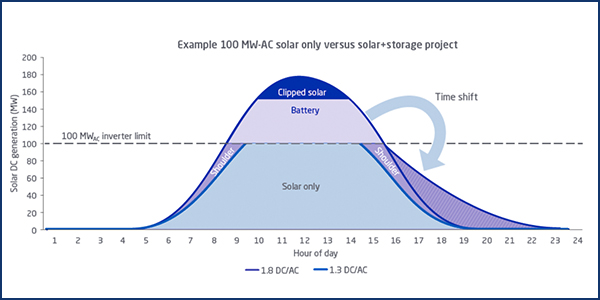By Michael Kuser
RENSSELAER, N.Y. — NYISO kicked off an effort Monday to develop a model for allowing large front-of-the-meter energy storage resources paired with generation to participate in its markets.
The Hybrid Storage Model project will evaluate the possibility of enabling co-located storage resources to receive a single dispatch schedule, Amanda Myott, NYISO capacity market design specialist, told the Installed Capacity/Market Issues Working Group (ICAP-MIWG).
NYISO sees developers increasingly coupling generation resources with storage resources, but its market rules do not include a participation model for such resources. Co-located resources are currently required to be separately metered and have their own point identifier, Myott said.
The ISO has filed related market rules for co-located distributed energy resources and energy storage resources (ESRs) with FERC (ER19-2276).
FERC in December partially accepted the ISO’s plan to comply with a mandate to develop rules to provide energy ESRs full access to their wholesale markets. (See FERC Partially Accepts NYISO Storage Compliance.)
However, the commission also required NYISO to alter its Tariff to provide more details on its “metering methodology and accounting practices for [ESRs] located behind a customer meter.”
Project Details
Asked where the hybrid model would fit in the ISO’s market structure, Myott said, “We imagine where DER caps at 20 MW, hybrid storage could fit in above that.”
Zachary Smith, the ISO’s manager for capacity market design, stepped in to answer whether hybrid storage would be eligible to withdraw electricity from the grid to alleviate excess supply.
“We would consider a hybrid storage resource to be similar to a DER aggregation, and any DER aggregation that contains storage is eligible to bid withdrawal,” Smith said.
Mark Younger, of Hudson Energy Economics, wanted the ISO to clarify what it meant by co-located: “Two resources connecting into the same interconnection node, whether 345 kV or 115 kV — is that what same location means at its most basic?”
“Yes, that was our initial thinking for resources at the same physical location,” said Mike DeSocio, the ISO’s director of market design.
Myott said the market design could be multifaceted, with some elements of the design being advanced faster than others. The elements include participation in NYISO’s energy, ancillary services and installed capacity markets; a settlement process; modeling for interconnection, planning and operations; and metering requirements.
Hybrid Resources as Power Plants
Explosive growth in solar plus storage projects — both co-located and full hybrid designs — is driving the market, said Mark Ahlstrom, vice president of renewable energy policy at NextEra Energy Resources and president of non-profit Energy Systems Integration Group, who presented on hybrid resources being offered into the market as conventional generators.
“A hybrid is a completely different beast, it’s no longer just a PV plant,” Ahlstrom said.
“All that I’m showing you has been shared industry-wide at [the Energy Systems Integration Group], NERC and other meetings, because we all know we have to work it out together,” Ahlstrom said. “And all this is fresh, from the last 12 months. California is perhaps the furthest along, now taking comments on their second straw proposal for hybrid resources, such as solar PV plus lithium-ion storage.”
“AC coupling of PV and storage as the same point of interconnection is what you think of first, and that can work. But DC-coupled designs have a number of attractive features that can increase efficiency and make them more cost effective. For example, AC inverters have to get up to a minimum DC voltage level before they can convert the DC power from the PV panels to AC power, but a DC-to-DC converter can work at lower voltage levels to move energy into the batteries, say, when the sun is just coming up,” he said.
Oversizing the PV panels on the DC side allows access to “a lot of capability sitting there … energy that would otherwise be thrown away, unable to be put on the grid, but can now be used to charge the batteries and later provide many services to the grid,” Ahlstrom said. “And it doesn’t have to be renewables; it could be gas plus storage.”
He advocated an “intelligent agent” approach based on analytics whereby the hybrid operator internalizes the characteristics of the components of the hybrid resource behind the point of interconnection (POI) and offers energy or ancillary services at the POI in the same way as a conventional resource, but with more flexibility and fewer constraints.
“We expect it to be treated like a conventional resource, not like a renewable resource,” Ahlstrom said. “You manage the state of charge through your offers.”
In describing the benefits to system or market operators, Ahlstrom said the “big breakthrough for me about a year ago” was when he saw how hybrid resources do not need to curtail renewable output for the headroom required to provide other need services (such as frequency response), which is instead a function of the battery’s state of charge. “Battery flexibility is what drives all of this,” he said.
Ahlstrom asserted that operated as a single resource, hybrid resources will eventually change market products, market design and market participation.
With no advance commitment, startup costs, minimum generation levels or other constraints, Ahlstrom asked, “will we build standalone storage, or mostly just hybrid resources?”
He closed by posing more questions: “Which is better, a highly flexible generator or a battery storage resource? What, exactly, is the difference? How does it affect planning, markets and operations?”
NYISO plans to complete the Hybrid Storage Model proposal this fall.





